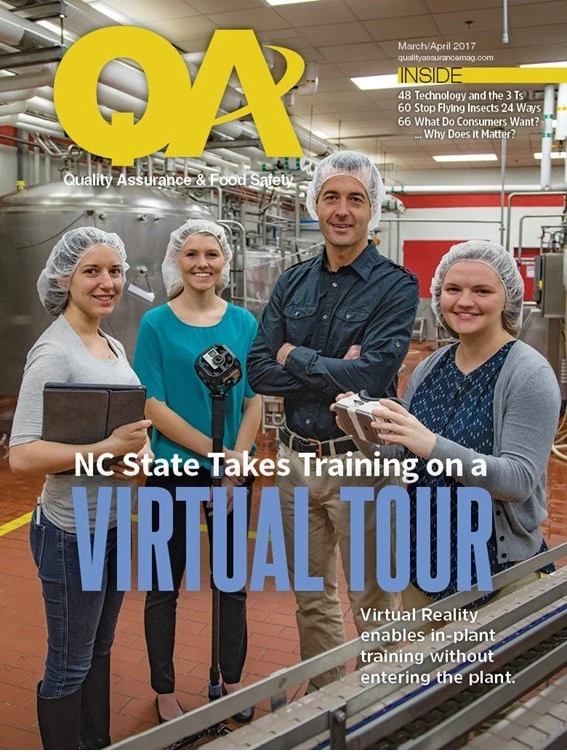
By Jennifer McEntire and Jim Gorny
When an inspector walks into an off-farm packinghouse, it should be evident which FSMA rule the inspector needs to assess compliance against: Preventive Controls or Produce Safety. As it stands today, however, a simple determination isn’t possible.
The inspector would need to first dig out documents pertaining to the ownership of the packinghouse. Then the inspector would need to determine the source of all the produce packed (for the past year ... or three years? we’re not sure) to determine the percentage of the produce packed which originated from the farm(s) that own the packinghouse. In the case of a packinghouse owned by a co-op, this could be a lot of legwork. But it is only after the inspector gets a handle on this ownership issue that he or she can determine if the operation falls under the Preventive Controls or Produce Safety rule.
There has to be a better way. There is.
If an operation is simply packaging, packing or holding fresh produce that is a raw agricultural commodity (RAC):
- If the product is not substantially transformed (e.g., it’s an apple going in and an apple going out), it should fall under the Produce Safety Rule.
- If it’s transformed (e.g., a sliced apple going out) it should be under Preventive Controls.

Does this impact the safety of the product? No. The Preventive Controls rule includes updated Good Manufacturing Practices. While not termed as such, the Produce Safety rule has nearly identical requirements scattered throughout the various subparts of the rule. FDA recognized the parity between the rules by allowing facilities conducting “off-farm packaging, packing and holding of raw agricultural commodities that are produce” to demonstrate compliance with GMPs by following either rule.
Some could argue that the Produce Safety rule is more stringent in terms of food safety requirements because microbiological hazards are assumed to be there — unlike in Preventive Controls, where Preventive Controls Qualified Individuals (PCQIs) can use judgment in the evaluation of whether a hazard requires a preventive control. The Produce Safety rule also has very prescriptive requirements around wash-water testing that are absent in Preventive Controls.
So, why is there confusion in the off-farm packinghouse issue that also affects cooling operations, warehousing/storage, etc.? Because Congress instructed FDA that the Preventive Controls rule would apply to facilities. This required FDA to re-evaluate the definition of “facility” which took us down a rabbit hole. FDA’s attempts to address the issue, while well intended, further complicated definitions resulting in increased confusion.
FDA has done a great job listening to produce industry concerns, however many produce businesses find the revised “farm” definition so convoluted and unclear that it is impossible to understand which rule applies to their operations and implement it with confidence. This inability to easily understand if a produce business meets the FDA definition of “farm”— and hence determine which FSMA rule they fall under — has created fear and anxiety of regulatory jeopardy in the produce community.
Last summer FDA published draft guidance intended to clarify when specific activities do and do not fall within the FDA definition of “farm.” The mere need for this guidance illustrates the complexity of the current “farm” definition. The draft guidance did not address what is meant by “under one management” and ‘”in one general (but not necessarily contiguous) physical location.” FDA noted its intent to help produce businesses figure out what rule they fall under on a case-by-case basis. Given the extraordinarily large number of firms involved, this approach is simply unworkable for businesses and overly burdensome for FDA.
In comments to the draft guidance, United Fresh Produce Association and the Produce Marketing Association (PMA), along with other produce associations, encouraged the agency to consider a proposal that foods that meet the definition of “produce” and “raw agricultural commodities” that remain the same product in commerce during postharvest handling be subject to coverage by the Produce Safety rule, irrespective of where they are grown, harvested, packed or held. This common-sense approach means that if a whole tomato remains a whole tomato when it goes through a packinghouse operation, the operation would be covered by the Produce Safety rule, irrespective of where that occurs. If that whole tomato is sliced or diced into a fresh-cut product, it has been substantially changed, meaning it is a different item because of processing, and it would be subject to the Preventive Controls for Human Foods rule.
This clear distinction between the coverage of the Produce Safety and Preventive Controls rules would strengthen enforcement and reduce confusion both for the produce industry and regulators. It also would provide uniform and effective regulation of all postharvest activities, irrespective of where they take place.
Congress allowed, in FSMA, an exemption from the Preventive Controls rule for facilities covered under the Produce Safety rule. Our interpretation is that we don’t need to be hamstrung in trying to define “farm,” since the Produce Safety rule can apply to produce whether in a farm or in a registered facility. In the comments, we also expressed our readiness to work with FDA and Congress, if need be, on a solution if it stems from how the FSMA statute was written. Let’s Keep It Simple.

Explore the April 2017 Issue
Check out more from this issue and find your next story to read.
Latest from Quality Assurance & Food Safety
- Chef Robotics Introduces Pat-Down Capability for Meal Presentation and Sealing
- USDA Launches Regenerative Pilot Program
- Indoor Ag-Con Adds Food Safety Track to Conference Lineup
- IDFA Recognizes Federal Officials for Support of U.S. Dairy Industry
- Tetra Pak Acquires Bioreactors.net
- Fresh Del Monte Receives Rabobank Leadership Award
- São Paulo Earns Guinness World Record for Largest Municipal Food Security Program
- KPM Analytics Releases Ready-to-Use NIR Calibration Packages





